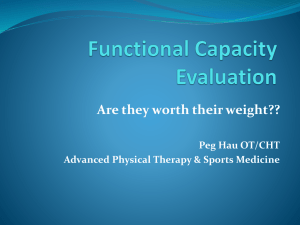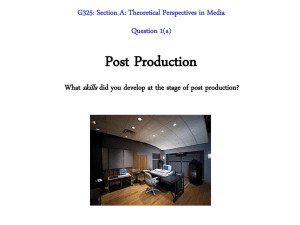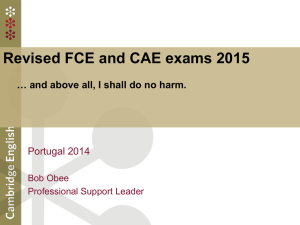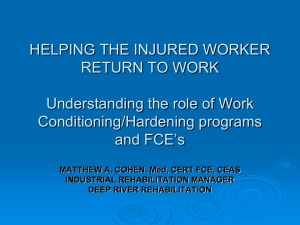People with chronic pain have undergone significant victimization
advertisement
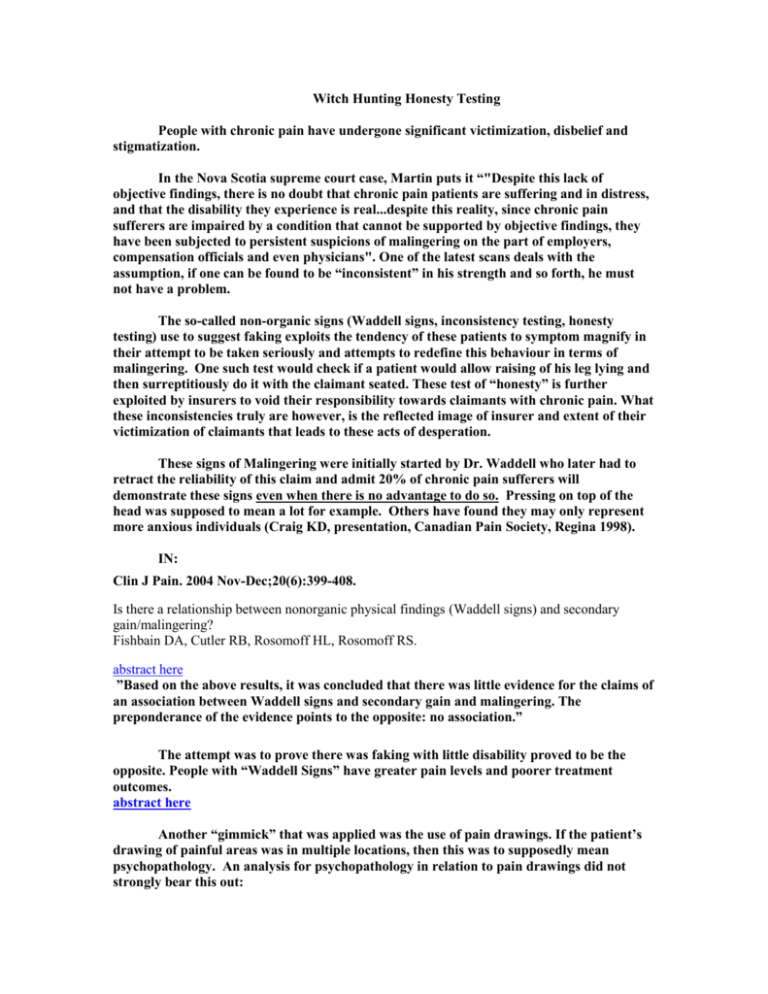
Witch Hunting Honesty Testing People with chronic pain have undergone significant victimization, disbelief and stigmatization. In the Nova Scotia supreme court case, Martin puts it “"Despite this lack of objective findings, there is no doubt that chronic pain patients are suffering and in distress, and that the disability they experience is real...despite this reality, since chronic pain sufferers are impaired by a condition that cannot be supported by objective findings, they have been subjected to persistent suspicions of malingering on the part of employers, compensation officials and even physicians". One of the latest scans deals with the assumption, if one can be found to be “inconsistent” in his strength and so forth, he must not have a problem. The so-called non-organic signs (Waddell signs, inconsistency testing, honesty testing) use to suggest faking exploits the tendency of these patients to symptom magnify in their attempt to be taken seriously and attempts to redefine this behaviour in terms of malingering. One such test would check if a patient would allow raising of his leg lying and then surreptitiously do it with the claimant seated. These test of “honesty” is further exploited by insurers to void their responsibility towards claimants with chronic pain. What these inconsistencies truly are however, is the reflected image of insurer and extent of their victimization of claimants that leads to these acts of desperation. These signs of Malingering were initially started by Dr. Waddell who later had to retract the reliability of this claim and admit 20% of chronic pain sufferers will demonstrate these signs even when there is no advantage to do so. Pressing on top of the head was supposed to mean a lot for example. Others have found they may only represent more anxious individuals (Craig KD, presentation, Canadian Pain Society, Regina 1998). IN: Clin J Pain. 2004 Nov-Dec;20(6):399-408. Is there a relationship between nonorganic physical findings (Waddell signs) and secondary gain/malingering? Fishbain DA, Cutler RB, Rosomoff HL, Rosomoff RS. abstract here ”Based on the above results, it was concluded that there was little evidence for the claims of an association between Waddell signs and secondary gain and malingering. The preponderance of the evidence points to the opposite: no association.” The attempt was to prove there was faking with little disability proved to be the opposite. People with “Waddell Signs” have greater pain levels and poorer treatment outcomes. abstract here Another “gimmick” that was applied was the use of pain drawings. If the patient’s drawing of painful areas was in multiple locations, then this was to supposedly mean psychopathology. An analysis for psychopathology in relation to pain drawings did not strongly bear this out: abstract here What is clear, is that chronic pain has been shown to cause damage to the dorsolateral prefrontal cortex which helps regulate mood, and neuralgic /CRPS pains damage the left orbitofrontal cortex which is associated with anxiety. abstract here abstract here Another honesty test was whether the pain extended further than expected from the nerve damage it entailed. For example, an S1 nerve root should cause pain primarily in the back of the leg. This however ignores the natural tendency for pain to spread to other areas. Mice, who have had their sciatic nerve tied with a stitch will develop excessive tenderness in areas not in the course of that nerve. abstract here Nerve root injuries to the neck hardly ever follow nerve root pain patterns; in Dr. N. Bogduk 2005 review of back and neck problems, he discusses that they tend to refer in a “somatic fashion” – the muscles innervated by the damaged nerve become tender, and they have their own pain referral patterns. To a doctor unfamiliar with this pain referral pattern, the patient will have his pain trivialized to just some knotted muscles. When these knotted muscles don’t get better, well then it must be the patient’s fault somehow… Some so called “honesty tests” have absolutely no validity. The use of the Straight leg raising test for consistency is the ultimate scam. It is one of the most unreliable tests and several researchers have found they are often not reproducible under any conditions: Reliability of the Lumbar Flexion, Lumbar Extension, and Passive Straight Leg Raise Test in Normal Populations Embedded Within a Complete Physical Examination. Clinical Case Study Spine. 26(24):2714-2718, December 15, 2001. Hunt, David et al abstract here “SLR and LROM scores used clinically are collected during comprehensive physical examinations. Most scores gathered under these conditions were not reliable” Spine. 1988 Apr;13(4):393-5. The clinical significance of straight-leg raising (Lasegue's sign) in the diagnosis of prolapsed lumbar disc. Interobserver variation and correlation with surgical finding. Kosteljanetz M et al abstract here [re SLR] “There was considerable interobserver variation among three observers concerning the measured angle at which pain was elicited.” Cases demonstrating mususe of these honesty tests have been seen in court: JONES v. BRITISH COLUMBIA (WORKERS’ COMPENSATION BOARD) Nov. 2003 where the WCB repeated exploited the tendency for this case to system magnify and turned his disability assessment into a contest of honesty. The court found (as per lancasterhouse.com)“The B.C. Court of Appeal may have put an end to nine years of decisions, reviews, and reversals within B.C.’s WCB when it indicated that the WCB did not perform the necessary task of determining the extent of a claimant’s disability. Instead, it became preoccupied with passing moral judgment on the claimant’s tendency to exaggerate his symptoms.” Much time can be spent passing this moral judgement with the deluded idea if the patient can be caught exaggerating, they are someone free of disability and WCB’s responsibility ends. Inconsistency tests are all under the misguided assumption that malingering is common when pecuniary rewards are in the offing. However, there are numerous studies that have demonstrated that after successful litigation, chronic pain subjects are not any better. There is a list of 19 such studies here: http://painmuse.org/ref/nobetterafter.doc People who are pushed into a corner where they have to prove they have a problem or die, will elicit inconsistent signs. All it demonstrates is the system - the victimization, trivialization, and disbelief they have had to contend with that leads them to this desperation – this pain behavior as mentioned earlier. These inconsistency tests are witchhunt tests and DO NOT have any relationship to actual disability except to demonstrate they are worse off – which is what Waddell signs have actually demonstrated. Hence they have no use in rehabilitation except to intimidate patients. Using this misinformation to terminate insurance benefits have generated considerable business for some health care workers, some of which is not honest. In one US federal court case, it was found “The FCE therapist had a computer macro that asserted symptom magnification and submaximal effort, before she conducted any evaluation or saw any patient.” One wonders who is the “faker” – the patient or the tester. from: article here Case in point – One of my patients with multiple injuries was told by a therapist to do maximally hand grip strength testing. This hand had several problems including trigger finger tendonitis. It hurt to grip, so her repeated tests results were different. This “inconsistency of grip” was prominently displayed in her assessment report. These tests are considered invalid when pain is present but this didn’t stop this therapist. Conclusion: - after the 2003 Nova Scotia Supreme courts ruling legitimizing chronic pain. Nova Scotia WCB had a “Chronic Pain: Consultants Summary 2004” published . In it, they stated: “An injured worker’s credibility should not be the focus of the assessment. The WCB is not impartial and therefore should not be making decisions about a worker’s credibility… Scoring credibility is not considered appropriate in a workers’ compensation environment…Judging a worker’s credibility is subjective and can make consistency in decision-making challenging as the credibility score is based on an individual opinion…As a result, the WCB will not score credibility as part of the Pain-Related Impairment assessment”. This would be my conclusion as well. The FCE Scam Many disability assessment tests have little to no scientific validity. Functional Capacity Assessments (FCE) are supposed to determine ability to return to work; The research so forth suggests that they are incapable of doing so. Therefore information from these assessments are not valid: J Occup Rehabil. 2005 Sep;15(3):285-94. Functional capacity evaluation performance does not predict sustained return to work in claimants with chronic back pain. Gross DP, Battie MC.Department of Physical Therapy, University of Alberta, Edmonton, Canada. abstract here He analyzed the “relative risk” – how much benefit a particular exercise test is in prediction: the highest he could come up with was 1.38. In order to be truly important, you need to see a relative risk over 3 – so they predict very little. Relative Risk described here This demonstrates how pathetic FCE assessments really are. Spine. 2004 Apr 15;29(8):920-4. The prognostic value of functional capacity evaluation in patients with chronic low back pain: part 2: sustained recovery. Gross DP, Battie MC. abstract here Stated: “The validity of Functional Capacity Evaluation's purported ability to identify claimants who are "safe" to return to work is suspect.” Results in shoulder injuries were the same: Occup Environ Med. 2006 Jun;63(6):404-10. Epub 2006 Mar 21. Does functional capacity evaluation predict recovery in workers' compensation claimants with upper extremity disorders? Gross DP, Battie MC abstract here CONCLUSIONS: Better FCE performance was a weak predictor of faster benefit suspension, and was unrelated to sustained recovery. FCE was no more predictive in claimants with specific pathology and injury than in those with more ambiguous, pain mediated conditions. The highest relative risks again were:”(HR) 1.5 to 1.7) and floor-to-waist lift (HR 1.2 to 1.3) tests were modestly associated with faster suspension of benefits” These results in prediction are so bad, they are pathetic – Since you would want a relative risk score of over 3 to be valuable and that wasn’t even close – to call it a weak predictor is a gross exaggeration. Some studies predicting ability to work are just laughable. For instance, it is invalid to test strength in a hand that hurts because it does not reflect strength – just pain. Now, one of the few studies to show FCE significance was a study that showed that: “Shultz (4), conversely, found a positive relationship between walking ability and return to work.” I think – they have to be kidding right?– obviously those in severe back pain are going to walk slower so this doesn’t measure a whole lot except how many painkillers the subject took that day. However, this is the state of our FCE sophistication. No wonder they do not predict much. I am sure throwing pain subjects in water, the one’s in least amount of pain, and had less time to deteriorate conditioning-wise could swim better. We could resurrect the witch-testing techniques of the middle ages and get just as good results as FCE’s. FCE tests do not reliably test anything that can predict well return to work. Pain level will given them much more information. Other studies were not that kind to FCE: “Newton and Waddell (1993) completed a thorough review of scientific evidence related to the use of Iso-machines (Iso-machines are commonly used for FCE’s) and found “no direct evidence on the relationship between Iso measures and actual muscle strength or functional capacity in realistic activities”. Berendt and Wuitchik (1998) used multiple measures including sit ups, walking speed and selected psychological measures. They found limited to no correlation between functional activities and return to work.” The condition has gotten so bad, that recent studies have tried to combine psychological factors with FCE to at last make it some use. What studies like to ignore and are pointed out in letters by reviewers, was that the by far the most important factor was the level of pain the patient was in. I have, in my yearly meeting to the Canadian Pain Society, have asked how FCE’s are used by various pain clinics. The answer I invariably get is that they are used to guide therapy, not to determine ability to go back to work. Most studies related to FCE were done in cases that were not WCB so there was no adversarial component to their rehab. It has been pointed out, justly so, that in the WCB setting, these tests might show even less that little predictive ability. Many of the above studies demonstrating the lack of accuracy of FCE’s have come from Edmonton – so very local. Another review of the relative uselessness of FCE’s comes from the Pain clinic in Canmore, Alberta: article here A quote: “The studies reviewed have demonstrated a lack of clear empirical support relating FCE results and prediction of return to work.” The use of these tests is very subject to individual variation of tester and the job demands of the patient. Case in point – patient of mine: lady injured at work spends her day lifting ?50 lb pallets (not sure of weight). For her final evaluation after rehab, she was asked to lift a full weight pallet once. She is told this proves she can go back to work. She tries but is has to get other parties at work to lift any of the heavy pallets. She gets another assessment from another physiotherapists who agrees that she is not capable of this work on a repetitive basis. These FCE represent a form of pseudoscience that WCB will use as an excuse to terminate coverage. It would be also a nice trick, to say if when they relapse, that their relapse is not a compensatable condition. This travesty must stop.
